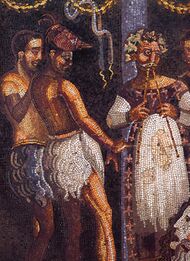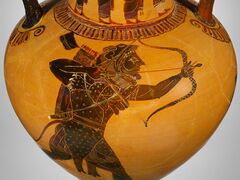Aulos
Topic: Engineering
 From HandWiki - Reading time: 6 min
From HandWiki - Reading time: 6 min
 | |
| Classification | Double reed |
|---|---|
| Related instruments | |
An aulos (Ancient Greek:, plural αὐλοί, auloi[1]) or tibia (Latin) was an ancient Greek wind instrument, depicted often in art and also attested by archaeology.
Though aulos is often translated as "flute" or "double flute", it was usually a double-reeded instrument, and its sound—described as "penetrating, insisting and exciting"[2]—was more akin to that of the bagpipes, with a chanter and (modulated) drone.
An aulete (αὐλητής, aulētēs) was the musician who performed on an aulos. The ancient Roman equivalent was the tibicen (plural tibicines), from the Latin tibia, "pipe, aulos." The neologism aulode is sometimes used by analogy with rhapsode and citharode (citharede) to refer to an aulos player, who may also be called an aulist; however, aulode more commonly refers to a singer who sang the accompaniment to a piece played on the aulos.
Types

There were several kinds of aulos, single or double. The most common variety was a reed instrument.[4] Archeological finds, surviving iconography and other evidence indicate that it was double-reeded, like the modern oboe, but with a larger mouthpiece, like the surviving Armenian duduk.[5] A single pipe without a reed was called the monaulos (μόναυλος, from μόνος "single").[4] A single pipe held horizontally, as the modern flute, was the plagiaulos (πλαγίαυλος, from πλάγιος "sideways").[4] A pipe with a bag to allow for continuous sound, that is a bagpipe, was the askaulos (ἀσκαυλός from ἀσκός askos "wineskin").[6]
Like the Great Highland Bagpipe, the aulos has been used for martial music,[7] but it is more frequently depicted in other social settings. It was the standard accompaniment of the passionate elegiac poetry. It also accompanied physical activities such as wrestling matches, the broad jump, the discus throw and to mark the rowing cadence on triremes, as well as sacrifices and dramas.[5] Plato associates it with the ecstatic cults of Dionysus and the Korybantes, banning it from his Republic but reintroducing it in Laws.
It appears that some variants of the instrument were loud, shrill, and therefore very hard to blow. A leather strap, called a phorbeiá (φορβεία) in Greek or capistrum in Latin, was worn horizontally around the head with a hole for the mouth by the auletai to help support the lips and avoid excessive strain on the cheeks due to continuous blowing. Sometimes a second strap was used over the top of the head to prevent the phorbeiá from slipping down. Aulos players are sometimes depicted with puffed cheeks. The playing technique almost certainly made use of circular breathing, very much like the Sardinian launeddas and Armenian duduk, and this would give the aulos a continuous sound.[citation needed]
Although aristocrats with sufficient leisure sometimes practiced aulos-playing as they did the lyre, after the later fifth century the aulos became chiefly associated with professional musicians, often slaves. Nevertheless, such musicians could achieve fame. The Romano-Greek writer Lucian discusses aulos playing in his dialogue Harmonides, in which Alexander the Great's aulete Timotheus discusses fame with his pupil Harmonides. Timotheus advises him to impress the experts within his profession rather than seek popular approval in big public venues. If leading musicians admire him, popular approval will follow. However, Lucian reports that Harmonides died from excessive blowing during practicing.
Mythic origin
In myth, Marsyas the satyr was supposed to have invented the aulos, or else picked it up after Athena had thrown it away because it caused her cheeks to puff out and ruined her beauty. In any case, he challenged Apollo to a musical contest, where the winner would be able to "do whatever he wanted" to the loser—Marsyas's expectation, typical of a satyr, was that this would be sexual in nature. But Apollo and his lyre beat Marsyas and his aulos. And since the pure lord of Delphi's mind worked in different ways from Marsyas's, he celebrated his victory by stringing his opponent up from a tree and flaying him alive.
King Midas was cursed with donkey's ears for judging Apollo as the lesser player. Marsyas's blood and the tears of the Muses formed the river Marsyas in Asia Minor.[8]
This tale was a warning against committing the sin of "hubris", or overweening pride, in that Marsyas thought he might win against a god. Strange and brutal as it is, this myth reflects a great many cultural tensions that the Greeks expressed in the opposition they often drew between the lyre and aulos: freedom vs. servility and tyranny, leisured amateurs vs. professionals, moderation (sophrosyne) vs. excess, etc. Some of this is a result of 19th century AD "classical interpretation", i.e. Apollo versus Dionysus, or "Reason" (represented by the kithara) opposed to "Madness" (represented by the aulos). In the temple to Apollo at Delphi, there was also a shrine to Dionysus, and his Maenads are shown on drinking cups playing the aulos, but Dionysus is sometimes shown holding a kithara or lyre. So a modern interpretation can be a little more complicated than just simple duality.
This opposition is mostly an Athenian one. It might be surmised that things were different at Thebes, which was a center of aulos-playing. At Sparta—which had no Bacchic or Korybantic cults to serve as contrast—the aulos was actually associated with Apollo, and accompanied the hoplites into battle.[9]
Depiction in art
Chigi vase
The battle scene on the Chigi vase shows an aulos player setting a lyrical rhythm for the hoplite phalanx to advance to. This accompaniment reduced the possibility of an opening in the formation of the blockage; the aulete had a fundamental role in insuring the integrity of the phalanx. In this particular scene, the phalanx approaching from the left is unprepared and momentarily outnumbered four to five. More soldiers can be seen running up to assist them from behind. Even though the front four are lacking a fifth soldier, they have the advantage because the aulete is there to bring the formation back together.[10]
Herakles in his tenth labor
An amphora from ca. 540–530 B.C. depicts Herakles in the process of completing his tenth labor. Auletes can be seen playing in a procession going around on the neck of the amphora.[11]
Modern use and popular culture
The sounds of the aulos are being digitally recreated by the Ancient Instruments Sound/Timbre Reconstruction Application (ASTRA) project which uses physical modeling synthesis to simulate the aulos sounds. Due to the complexity of this process the ASTRA project uses grid computing to model sounds on hundreds of computers throughout Europe simultaneously.[12][13]
The aulos is part of the Lost Sounds Orchestra, alongside other ancient instruments which ASTRA have recreated the sounds of, including the epigonion, the salpinx, the barbiton and the syrinx.[14]
The aulos was also featured in the 2009 movie Agora, wherein a character performs a solo in an amphitheatre. It is also visible in the 2007 movie 300.
Modern evolutions of the aulos exist in Southeastern Europe. In southern Albania, specifically, a double non-free aerophone resembling the aulos – called the cula diare or longari – is still played in the Labëria region to accompany Albanian iso-polyphony.[15] These instruments are woodwind and not double-reeded like the aulos of antiquity.
Gallery
Actress singing, actor playing aulos, girl playing cithara. Antique fresco in Herculaneum
Aulist performing for Isis in funerary art from Roman Egypt (Royal Ontario Museum, Toronto).
See also
References
- ↑ αὐλός, Henry George Liddell, Robert Scott, A Greek-English Lexicon, on Perseus
- ↑ The History of Musical Instruments, Curt Sachs, 1940
- ↑ Based on archaeological remains found at Pompeii
- ↑ 4.0 4.1 4.2 Howard, Albert A. (1893). "The Αὐλός or Tibia". Harvard Studies in Classical Philology (Department of the Classics, Harvard University) 4: 1–60. doi:10.2307/310399.
- ↑ 5.0 5.1 West, Martin L. (January 1992). Ancient Greek Music. Clarendon Press. p. 84. ISBN 0-19-814975-1. https://books.google.com/books?id=So-Qpz6WDS4C&pg=PA84. ""The single reed or clarinet mouthpiece was known to other ancient peoples, and I should not venture to assert that it was not known to the Greeks. But the evidence of both art and literature indicates that it was the double reed that was standard in the Classical period. Under the Hornbostel-Sachs system, therefore, the aulos should be classified as an oboe. It must be admitted that 'oboe-girl' is less evocative than the 'flute-girl' to which classicists have been accustomed, and that when it is a question of translating Greek poetry 'oboe' is likely to sound odd. For the latter case I favor 'pipe' or 'shawm.'""
- ↑ Flood, William Henry Grattan. The story of the bagpipe. Рипол Классик. ISBN 9781176344228. https://books.google.com/books?id=DOfuAgAAQBAJ&pg=PA15. Retrieved 21 April 2021.
- ↑ Herodotus, The Histories, 1.17.1, on Perseus
- ↑ Simon Goldhill, ed (2004). Performance Culture and Athenian Democracy. Cambridge: Cambridge University Press.
- ↑ "Hoplite". World History Encyclopedia. https://www.worldhistory.org/hoplite/.
- ↑ Hurwit, Jeffrey M. (2002). "Reading the Chigi Vase". Hesperia: The Journal of the American School of Classical Studies at Athens 71 (1): 1–22. doi:10.2972/hesp.2002.71.1.1.
- ↑ Moore, Mary B. (2013). "Herakles Takes Aim: A Rare Attic Black-Figured Neck-Amphora Attributed to the Princeton Painter". Metropolitan Museum Journal 48: 37–58. doi:10.1086/675312.
- ↑ "The ASTRA Project website". 27 June 2015. http://www.astraproject.org/index.html.
- ↑ "iSGTW | iSGTW". 5 September 2015. http://www.isgtw.org/.
- ↑ "Feature - The Lost Sounds Orchestra". 2 September 2009. http://www.isgtw.org/?pid=1001954.
- ↑ Eno Koço, "Vocal Iso(n)", Art and Humanities Research Council (British Research Council), July 2012
External links
- "The Aulos and Drama: A Performer's Viewpoint," by Philip Neuman
- "Ancient Greek Music – The Aulos, with sound examples"
- Ginsberg-Klar, Maria E. (February 1981). "The Archaeology of Musical Instruments in Germany during the Roman Period". World Archaeology 12 (3, Archaeology and Musical Instruments): 313–320. doi:10.1080/00438243.1981.9979806. "The tibiae (is) an instrument of the Romans.".
 KSF
KSF











